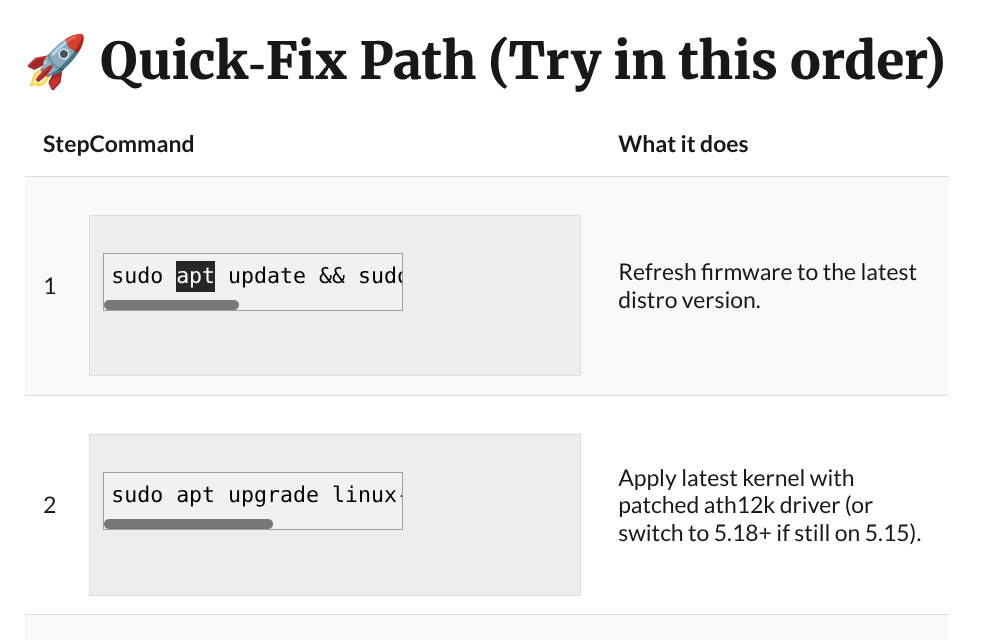an interesting perspective, @OpenInfra https://openinfra.org/open-infrastructure-blueprint-white-paper
this is to a similar model being developed by @minds
@librecomms
except we are more #opinionatedLinux using @UniversalBlue #aurora #kde #fedora #atomic FTW. #betheflow
Weekly GNU-like #MobileLinux Update (52/2025): #postmarketOS v25.12 and Other Last Minute Goodies!
https://linmob.net/weekly-update-52-2025/
#Phosh #Sxmo #SailfishOS #UbuntuTouch #Fedora #Pocketblue #FuriLabsFLX1s #MNTReformTouch #LinuxMobile #LinuxonMobile
@antenagora @mcbaumwolle I've been having similar issues with suspend since I update to the latest #Fedora. Sometimes `systemctl suspend -i` in the terminal does it better. Someone told me the issue but I do not remember, just learning to live with it. :(
So maybe someone on fedi can help me here, but after updating my #ThinkPad #T14 #BIOS to 1.17, #fedora can no longer #suspend normally and freezes and requires a hard power-off each time. I tried some #grub stuff, many suggested fixes I found on the internet and a newer kernel (6.18 instead of 6.17) but nothing worked. So I think it may be a #Lenovo issue.
#Unix #Linux #followerpower #askfedi #gnome #AMD #LVFS #laptop
Thanks! 
Weekly GNU-like #MobileLinux Update (52/2025): #postmarketOS v25.12 and Other Last Minute Goodies!
https://linmob.net/weekly-update-52-2025/
#Phosh #Sxmo #SailfishOS #UbuntuTouch #Fedora #Pocketblue #FuriLabsFLX1s #MNTReformTouch #LinuxMobile #LinuxonMobile
Any @fedora folks in the house?
I've just upgraded successfully from Fedora 40 (Mate) to 41. Now I'm trying to download the files to upgrade from 41 to 42, but I'm getting a curl error, because it's trying to pull a file from;
Is that a bug or a process error on my part? Can I carry on with the upgrade, or am I risking a borked system?
(1/2)
Friends,
Is there a good kind of course/ guide/ how to for learning how to use the terminal (I'm currently running Fedora Linux) for dummies. No crypic abbreviations, no "run this string of code" and then no further explanation, no assuming I know anything but how to open the terminal. Something that starts with telling me what everything means that I see even when I first open the terminal. How to do the most basic things, before going into the more interesting things. One stept after the other.
Please tell me there is such a thing? I really want to learn.
#Fedora #FedoraLinux #Linux #Terminal
I'm stuck with an apparently simple situation trying to run a #mediawiki development environment with #podman on #fedora ... Just in case anyone has the right tip to solve this problem with permissions, here is the full writeup:
🕹️ Fedora Games Lab Looks To Be Revitalized As Modern Linux Gaming Showcase - Phoronix
「 The proposal for Fedora 44 is to rework Fedora Games Lab to be a better showcase for Linux gaming, which would also include switching away from Xfce to KDE Plasma to better support Wayland and other modern Linux desktop technologies. The new Games Lab would focus not only on "high quality" gaming but also on Linux game development 」
OK #fedora users: how are you doing Signal on desktop?
Today I finally release #PKGMGR 1.0.0 🎉
A multi-distro workflow & package manager built on #Python + #Nix. It unifies repo management, builds & releases and now stabilizes and future-proofs @infinito development and deployment.
More: https://s.veen.world/pkgmgr
#Linux #DevTools #Nix #FOSS #Automation #MultiDistro #ArchLinux #Debian #Ubuntu #Fedora #CentOS #DevOps #CI #OpenSource #InfinitoNexus #NixOS #Arch #ArchLinux
It is a sad day, at the same time I look back and realize the journey was beautiful and taught me a lot.
I am no longer running a 100% #guix system. I got tired of things breaking, being removed without warning or explanation, undocumented things, cryptic error messages.
I am but one person and cannot afford to debug stuff everyday.
I therefore took the pragmatic choice of scripting some things on top of #fedora and spread the risk, with #guix #nix #flatpak and #dnf packages.
cc: @rafa
Fedora Magazine is pushing generative AI to ask how your system "feels." 🤮
One troubleshooting suggestion is using an APT command instead of, you know, DNF...
The author doesn't even call out the glaring mistake, only saying "Not too bad an analysis and set of debugging steps!"
This shouldn't have been published. This is embarrassing and infuriating on many levels. @fedora
Article: https://fedoramagazine.org/find-out-how-your-fedora-system-really-feels-with-the-linux-mcp-server/
Fedora: Open-source repository for long-term digital preservation
#HackerNews #Fedora #OpenSource #DigitalPreservation #LongTermStorage #TechNews #OpenSourceCommunity
@fedora I tried again tonight with upgrading Fedora 41 to 42. Went off without a hitch. I guess either our place was having net connection problems last night, or the mirror I was trying to pull from was, or I just wasn't holding my mouth right : P
I am having one little post-upgrade issue with @fedora 42.
Every time I open dnfdragora it asks me to import a GPG key, which appears to be associated with the @librewolf repo. But the text here doesn't seem to match the string I'd expect from a GPG key, it's not long enough for one thing.
The LibreWolf repo was all working fine in #Fedora 40 and 41, so not sure what's going on here. But again, I'm fairly new to Fedora, so could well be a rookie mistake on my end : )
Today I finally release #PKGMGR 1.0.0 🎉
A multi-distro workflow & package manager built on #Python + #Nix. It unifies repo management, builds & releases and now stabilizes and future-proofs @infinito development and deployment.
More: https://s.veen.world/pkgmgr
#Linux #DevTools #Nix #FOSS #Automation #MultiDistro #ArchLinux #Debian #Ubuntu #Fedora #CentOS #DevOps #CI #OpenSource #InfinitoNexus #NixOS #Arch #ArchLinux
Fedora Magazine is pushing generative AI to ask how your system "feels." 🤮
One troubleshooting suggestion is using an APT command instead of, you know, DNF...
The author doesn't even call out the glaring mistake, only saying "Not too bad an analysis and set of debugging steps!"
This shouldn't have been published. This is embarrassing and infuriating on many levels. @fedora
Article: https://fedoramagazine.org/find-out-how-your-fedora-system-really-feels-with-the-linux-mcp-server/
Any @fedora folks in the house?
I've just upgraded successfully from Fedora 40 (Mate) to 41. Now I'm trying to download the files to upgrade from 41 to 42, but I'm getting a curl error, because it's trying to pull a file from;
Is that a bug or a process error on my part? Can I carry on with the upgrade, or am I risking a borked system?
(1/2)
An interesting theme I keep seeing popping but is that system package managers don’t need all the features that language package managers have, like lockfiles.
I suspect it’s more of a cultural thing but definitely needs more investigation into what’s really going on behind those comments.
@andrewnez Lockfiles for package managers are called repofiles. 😊 The entire distribution is a single lockfile. In #Fedora, we make a new compose every night. Compose can fail for many reasons. And successful compose does not yet means that every package is installable. Here is a good starting place for your rabbit hole https://github.com/osbuild/osbuild-composer
Is it cool that Linus Torvalds uses Fedora Linux? Yes!
But the really cool thing is to use the Linux distro that works best for you. :)
Having Linux get covered on LTT is such a big win for the open source community as more techies realize there is another way!
➡️ https://www.youtube.com/watch?v=mfv0V1SxbNA
But it is pretty neat tho what Linus uses 😎




